From a Certain Point of View: By the Numbers
Page Counts, and Word Counts, and Phrase Counts, Oh My!
Book editors, by and large, are not really known as numbers people. I’ve definitely sat in editorial meetings where the phrase “I was told there would be no math” was actually uttered without the least bit of irony.
But, in another life (and what feels like another galaxy), I was a professional numbers person.1 I obsessed over balance sheets and transaction portfolios with the same fervor that I now do story outlines and line edits. Despite that shift, I’m still fascinated by numbers, particularly when it comes to books. And every once in a while, my colleagues stare at me and say “I was told there would be no math.”
Welcome back to the Cubicle at the End of the Galaxy. This week, we’re looking at some of the fun stats behind the Star Wars: From a Certain Point of View series. And later on, I’ll be sharing more insights and development tidbits about the second batch of stories in From a Certain Point of View: Return of the Jedi.
Words, Words, Words
40 Years. 40 Stories. 40 Authors
5 Years. 3 Anthologies. 120 Stories. 108 Authors. That yields a lot of pages and a lot of words. But how many exactly? Well, let’s take a look:
From a Certain Point of View Series
Pages: 1,664
Words: 452,340
(the page counts include things like - the title page, copyright page, and “about the text”, etc which generally aren’t numbered inside the book)
How does that look, per book? Something like this:
From a Certain Point of View: Star Wars
Pages: 496
Words: 132,090
*This first anthology had 43 contributors since we had three writing pairs. Oddly enough, we had no author pairings in the latter two installments.
From a Certain Point of View: The Empire Strikes Back
Pages: 576
Words: 157,554
From a Certain Point of View: Return of the Jedi
Pages: 592
Words: 162,696
There’s a pretty clear trajectory of the anthologies getting bigger and longer as the series progresses. That was wholly unintended. Across all three books, our rules for story length never changed, so what happened? Here are my three best guesses.
Folks like writing Star Wars stories, and given the chance, why not write as robust a story as you can? Simple as that.
As the anthology series become more established and writers saw the various kinds of stories and approaches that were possible, they became more ambitious.
Many of the scenes in ESB and ROTJ are less defined (cutting into/between each other) which may have prodded some authors to push the bounds of their story further to create a better sense of a beginning-middle-end.
*Quick little publishing tangent - within the industry, we track book length in terms of word, not page count. Page count can be influenced by all sorts of things like book dimensions (trim size), font size, margins, etc. But, word count is word count.
Total word count is interesting enough, but what about specific words?
Seeing both uses of “Force” and “Jedi” increase in the two later entries makes sense, as those concepts become more central to the story of Star Wars as the original trilogy goes on. Interestingly enough, the phrase “dark side” appears only 33 times in the whole trilogy and also sees a sizeable jump in the latter part of the series (4 / 15 / 14).
The explosion of “hope” in the second entry can mostly be tracked to the Hoth stories, many of which followed rebels who tracked their reason for joining the cause, or reason for continuing to fight to “hope”. We might also call this the “Jyn Erso effect”.
If you’re wondering about those last two words, there are some long-running jokes about certain words appearing in Star Wars novels, so it’s just a bit of fun.
Stories, Stories, Stories
Leaving the realm of individual words, let’s look at how the 120 stories break down by POV characters.
The main four categories are relatively consistent across all three books, though if you told me we’d have more Imperial POVs than rebel overall across the trilogy, I would have been a bit surprised.
The “other” category, includes - Jedi / Force ghosts / galactic citizens/aliens. I suppose I could have broken these out into their own categories, I didn’t want to have a bunch of categories that had one entry.
Of note here is the drastic bump in original characters after the first book. The reasons, I would guess, are similar to those behind the jump in word count we discussed above. Particularly the issue of intercutting scenes and the number of “faceless” characters in ESB / ROTJ, like TIE pilots chasing the Falcon or scout troopers on Endor. Which then probably feeds into the consistent presence of Imperial POVs.
Authors, Authors, Authors
Words and stories are cool, but they’re nothing without authors to write them.
Of the 108 unique contributors, only 3 wrote stories in all three anthologies. While 10 wrote in two anthologies. Of the two timers, 9 wrote in ANH-ESB and only 1 wrote in ESB-ROTJ. No authors wrote just in ANH-ROTJ
But as I discussed previously, we really valued being able to use the series as an on-ramp for new or less experienced voices into the galaxy far, far away.
These numbers are fun and intriguing, but then I had a thought. How does all of this compare to the entire publishing history of Star Wars? Well, I’m not about to count the appearances of “the Force” in every Star Wars book ever published, or the number of stories about rebels, but we can look at the authors themselves.
But first, we’ve got to define the word “author.” Because when you ask “how many Star Wars authors” have there been, that’s a question with about as many answers as “how much time passes in The Empire Strikes Back?” So, I decided to focus on “prose fiction storytellers”. Anyone who has ever written a Star Wars novel (adult / ya / mg etc.) or a short story that was published in a magazine (like Star Wars Insider) or as part of a fiction book (novel or anthology). 2
Defining things that way yields 253 authors.3 And so, with 108 unique contributors in the series, that means that just around 43% of all Star Wars prose fiction storytellers have been part of this trilogy. Nearly half, which is ridiculous (and cool).
But we can go one step further. What percentage of all those prose storytellers made their Star Wars debut in FACPOV? The answer there is 30%. Which might be the stat that means the most. Because Star Wars gets better when you bring new voices to it. And if you want to create beloved authors who can write for decades in the galaxy far, far away, you have to start with that first story.
From a Certain Point of View: Return of the Jedi Insights: Part II ~ Imperials, Rebels, and Ewoks
There are so many stories about the development of this latest anthology. Heading toward release, I’m sharing at least one anecdote, behind-the-scenes tidbit, or additional context why you’ll want to check out all forty stories and authors, come August 29th. In addition, there’s at least one recommendation for other writing/work by each author, because they are all brilliant creators whose work you should explore.
Today, we’re tackling stories 12 - 26.
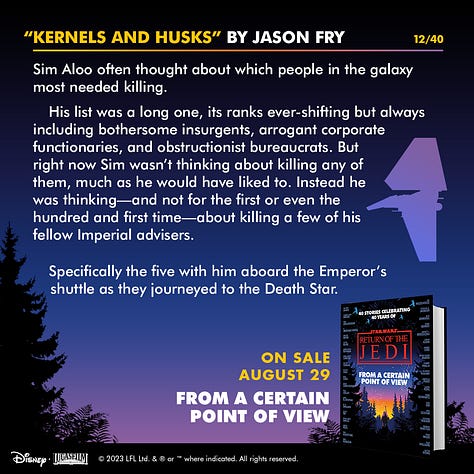
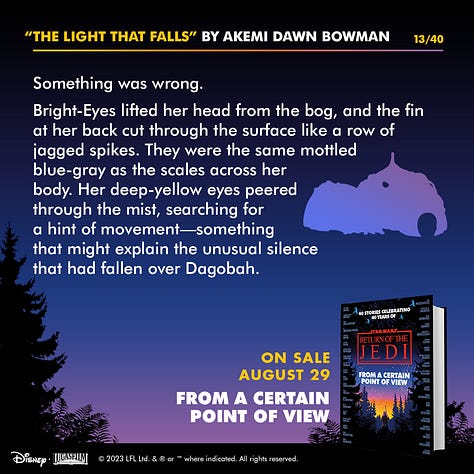
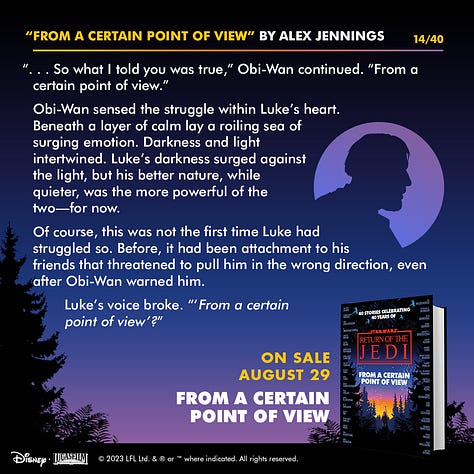
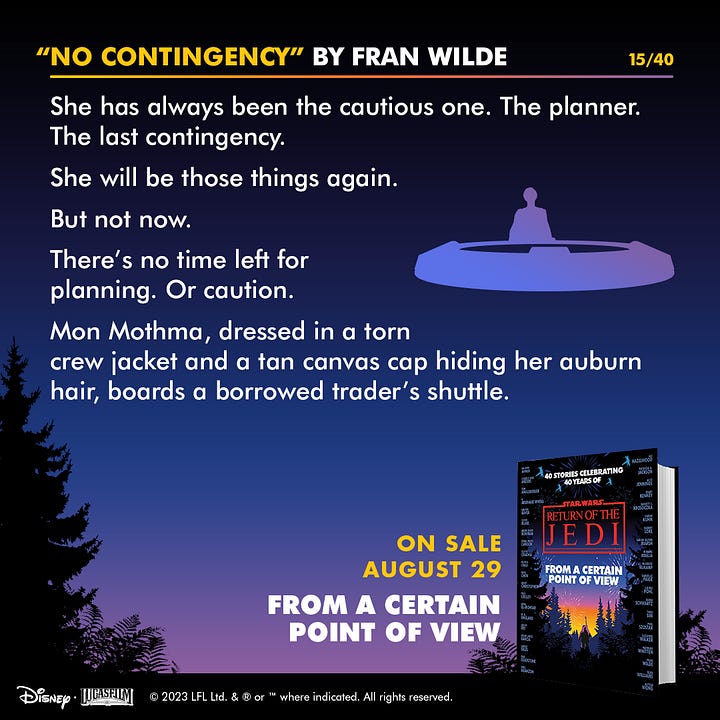

Kernels and Husks by Jason Fry
You can always count on Jason Fry to push the bounds of what a Star Wars short story can be. His FACPOV: ANH pitch of “I want to tell the story of fake Wedge” was a lightbulb moment when I knew we’d stumbled onto a really amazing project.
For this story, Jason is telling a more straightforward tale, but no less weird and wonderful. Delving into why exactly an all-powerful galactic emperor needs “advisors” is one thing. But in true author (and journalist fashion) Jason was inspired by a real-life story and wondered if that circumstance could be used for murder.
Also check out: Servants of the Empire series, The Jupiter Pirates series
The Light That Falls by Akemi Dawn Bowman
Another example of a quiet story that manages to create one of the loudest impacts. Akemi Dawn Bowman choose the POV of the dragonsnake - the watery creature on Dagobah that meets R2-D2 - to tell a story about a place, and how it changes. It’s a deeply immersive story about life on Dagobah, particularly how it feels to live there, and how the presence and loss of beings irrevocably change a place. It’s one of the most remarkable examples of the connectivity and balance of all things in the Force, though the word itself never appears in the story.
Also check out: The Infinity Courts and Starfish.
From a Certain Point of View by Alex Jennings
This story had to exist and is one of very few tales across three anthologies that the editorial team stipulated would need to be included. Luckily, Alex Jennings arrived with a terrific and poignant perspective on how both Obi-Wan and Luke arrive at this moment. A moment that’s a turning point for so much of ROTJ, the original trilogy, and frankly this anthology series. Alex found a way to pack all of that into a story without ever pulling us out of that moment where Obi-Wan takes a deep breath and finally tells Luke the whole truth. In particular, the way Alex leveraged the physical performances and deliveries of both Alex Guinness and Mark Hamill to mine what was beneath the surface of that conversation, is stunning.
Also check out: The Ballad of Perilous Graves
No Contingency by Fran Wilde
One of the many gifts of the FACPOV anthology series is being able to look back at characters during the original trilogy with new context. Nowhere is that more true than with Mon Mothma, thanks to the expansion of her story in Star Wars: Rebels and Andor. In coming to the character Fran was keen on not just creating a Mad Lib of memories and references, but giving Mon a story about action informed by all those years of planning, and ordering, but not acting.
Fran’s story is well in conversation with Alex Freed’s “The Last Contigency” story from the original FACPOV.
Also check out: Updraft (The Bone Universe) and Riverland
The Burden of Leadership by Danny Lore
Danny Lore choose a fascinating aspect of Lando Calrissian’s journey to explore. A situation where all the bravado, guile, verbal sleight-of-hand, and general charm that he’s known for won’t work. In pulling that all away, Danny gives us a view of Lando at his most vulnerable, but also at a moment of real change for the character. And the result is utterly thrilling.
In a fun bit of full-circle serendipity, Danny and I first met almost 10 years ago playing weekly D&D at a gaming shop in Brooklyn.
Also check out: Comics (DC/Marvel/Vault/etc)
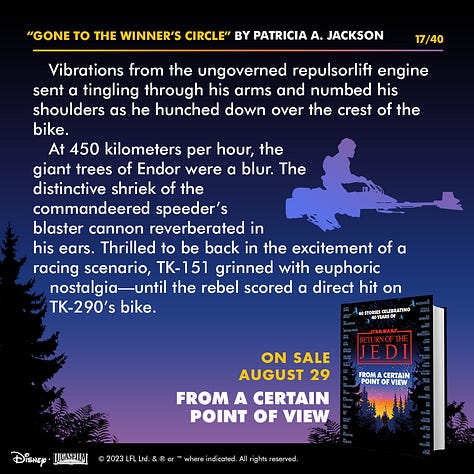
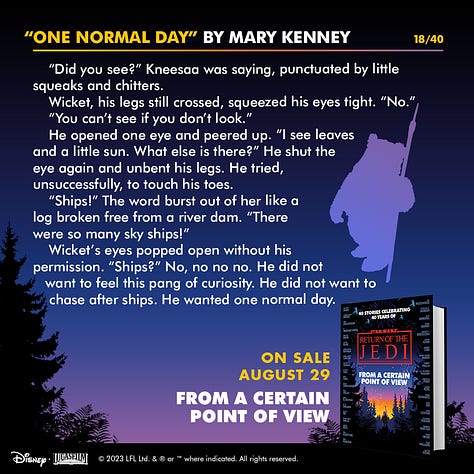
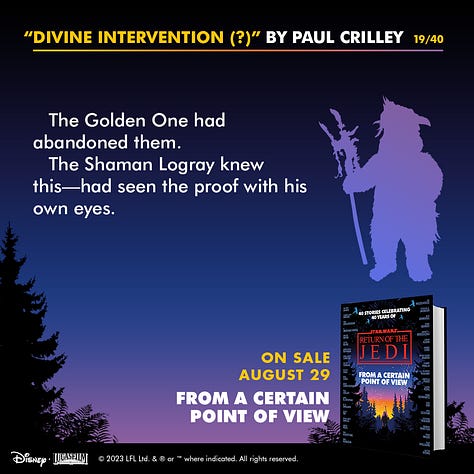

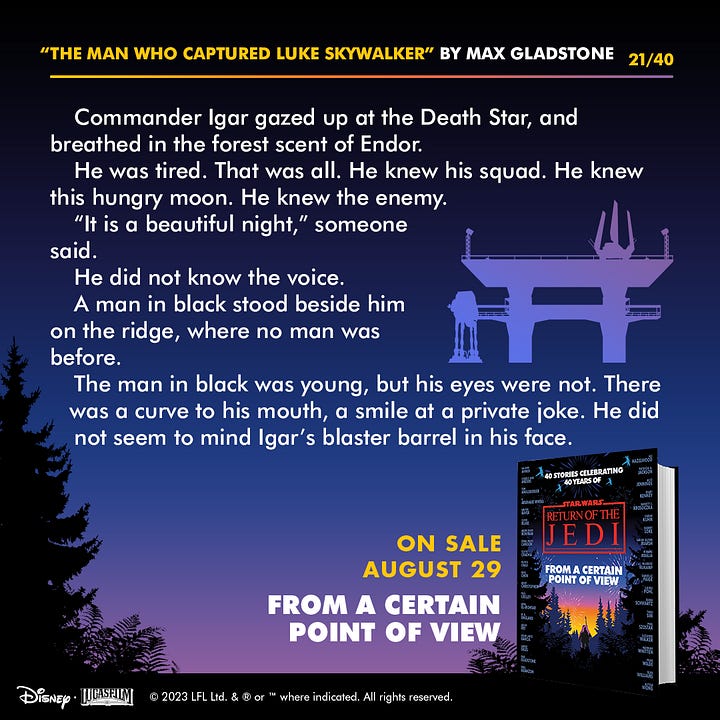
Gone to the Winner’s Circle by Patricia A Jackson
Having a legendary Star Wars contributor like Patricia A. Jackson back is fantastic, and she brought with her a fantastic story that achieves something rather difficult. Translating the sense of speed, thrill, and impressive visual flourish from screen to page. Her story that covers the iconic speeder bike chase through the forest of Endor may have you leaning in your seat along with the story, swooping around the giant trees.
Patricia’s eye for intricate technical detail to make the tech of Star Wars feel more real has never been better, but it’s truly conveying that need for speed of the POV character to the reader that will most take your breath away.
Also check out: Forging a Nightmare
One Normal Day by Mary Kenney
The story that asks the question (perhaps unintentionally) “is Wicket secretly just like Bilbo Baggins?” and do Ewoks simply yearn for the same things that Hobbits do: “peace and quiet, and good tilled earth. For all Hobbits share a love of things that grow”?
A cozy read if there was one, and a story that is just crying out for adaptation as a children’s picture book. A charming Ewok adventure with a relatable star, because who hasn’t had the strong desire to do nothing all day, only to find that the fridge is empty and you have grocery shopping and chores to do?
Also check out: Gamer Girls and Marvel’s Spider-Man: Miles Morales (Playstation)
Divine (?) Intervention by Paul Crilley
Each of the four Ewok-centric tales in this anthology has its own tone and vibe. In Paul Crilley’s examination of Logray we get our best look at the intricate (and sometimes tense) relationships among the leadership of the Ewoks. Beyond that, Paul pulls back the depth of the disruption that “the golden one’s” arrival on the Forest Moon brings to the denizens of Bright Tree Village.
Also check out: Department Zero
The Buy-In by Suzanne Walker
Suzanne and I had a really interesting conversation to start her story process. How many of the rebels knew that the attack on the second Death Star was likely the “end” of the rebellion, either way? And of those that did recognize that would they tell anyone that didn’t? Should they?
Into this murky water steps Norra Wexley, and Suzanne’s intimate portrait of guilt, anxiety, worry, and fatigue for a pilot on the verge of battle. A story that cuts deep, but never loses itself to despair. And an amazing return to a character that debuted in the Aftermath trilogy, nearly 10 years ago. By the way, do not miss the incredible interactions that Norra has with Lando. Their banter is so good, I’d sign up for multiple adventures of those two in a heartbeat.
Also check out: Mooncakes
The Man Who Captured Luke Skywalker by Max Gladstone
Max’ story was one of the first manuscripts that came in, and it certainly set a tone! Max’ story fits right into that mold of quiet tales that speak volumes that’s coming to define part of this book. Max took on a real challenge, as any writer (and editor!) will tell you that writing Luke Skywalker - particularly at this point in time - is a real challenge, given the economy of words Luke tends to use, and the need to rely on the silence between words, and his demeanor (Mark Hamill’s performance is peerless) to really make the character feel authentic. Max not only accepted the challenge, he crushed it.
An amazing story to pair with any of the Ewok POV tales, giving an amazing dichotomy of the forest moon of Endor.
Also check out: This is How to Lose the Time War (with co-author Amal El-Mohtar).
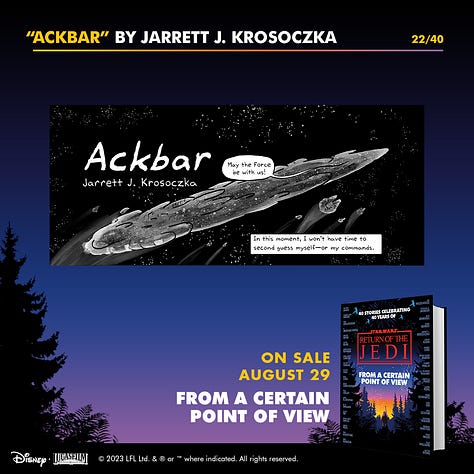
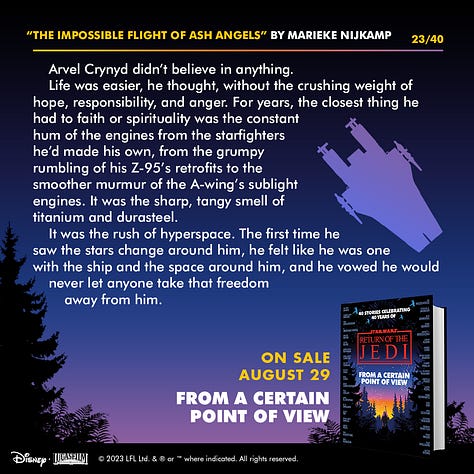

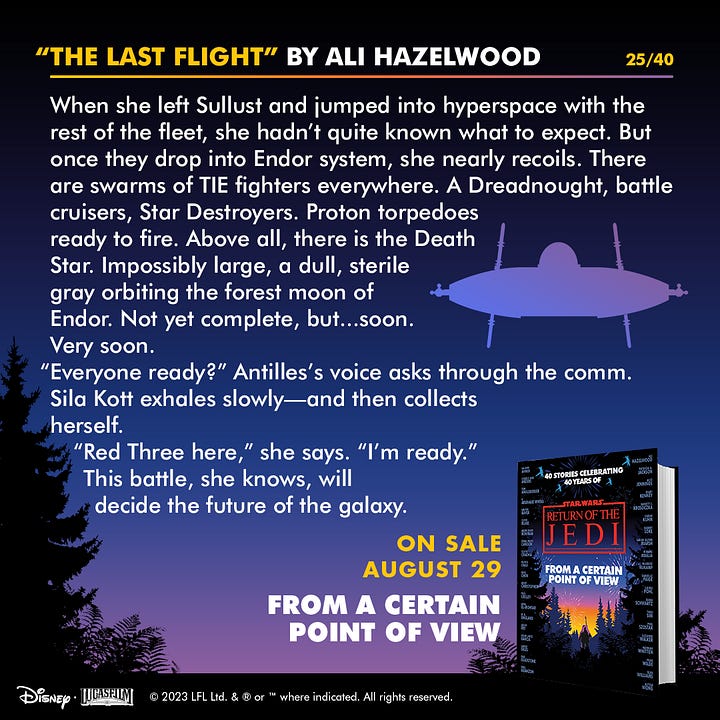
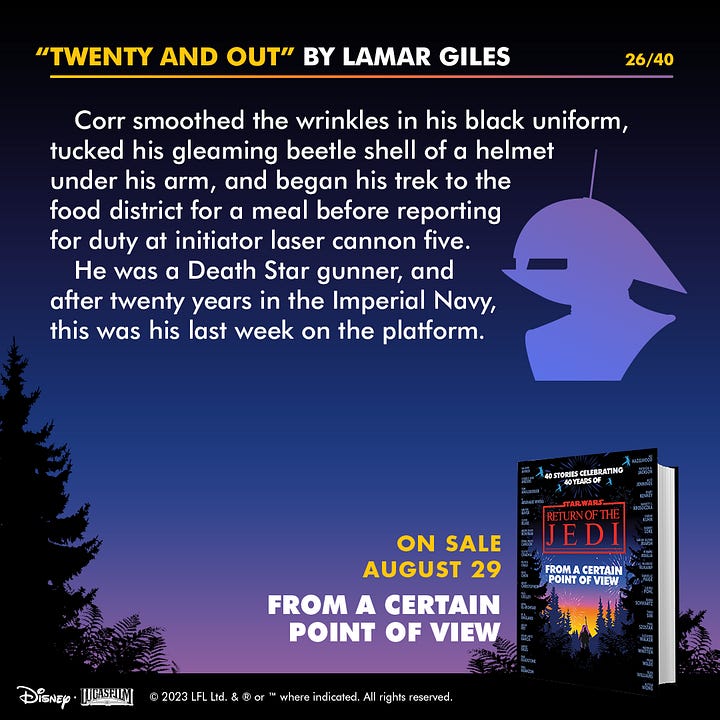
Ackbar by Jarrett J. Krosoczka
Having a short comic as part of the anthology has become a nice little tradition, and Jarrett was the perfect choice to continue that. While previous comics have been just one page, Jarrett extends his to tell a bit more of a portrait of the Admiral on the verge of battle, giving us deeper insights into the character who has become more of a meme than just about any other. And Jarrett did the admiral great justice.
Check out a bit of Jarrett’s design and drawing process here!
Also check out: Jedi Academy: A New Class and Hey, Kiddo
The Impossible Flight of Ash Angels by Marieke Nijkamp
A story about finding a reason - not to fight - but to believe in what you’re fighting for. Rather than dig into the tactics and maneuvers of the space battle, Marieke opts instead for a story about those final moments before action, the “deep breath before the plunge.” Marieke’s story fully rounds out a character known only as “Green Leader” before that, and by inching us closer and closer to the battle without ever tipping over into it, she creates incredible tension that might have you gripping the edges of your book.
Also check out: Critical Role Vox Machina: Kith and Kin and Before I Let Go
Ending Protocol by Hannah Whitten
Star Wars is always about hope, but it’s also about a choice for and a chance at redemption. Hannah’ stormtrooper story foreshadows many of the themes and story beats that the galaxy will face and reckon with in the aftermath of the Battle of Endor. A grounded, stark look at what it’s like behind the mask of a stormtrooper and the push/pull of identity and duty.
Also check out: For the Wolf
The Last Flight by Ali Hazelwood
Who do we fight for, and what do we sacrifice in order to protect them are the questions at the heart of Ali’s story. One of the stories that surprised me the most in execution, and one that will make you feel like you’re sitting in the cockpit right alongside Sila Kott as she launches into battle.
Also check out: Check & Mate, The Love Hypothesis
Twenty and Out by Lamar Giles
A Death Star worker’s “last week on the job” sort of tells you all that you need to know about Lamar’s story. A mix of comedy, absurdity, and the banal office-like existence of front-line Imperial workers. Everyone knows that nothing ever goes wrong during the last week on the job, right?
Also check out: The Getaway
In the Next Dispatch from the Cubicle…
We wrap up the remaining mini-essays on From a Certain Point of View: Return of the Jedi. Plus, a few more retrospective anecdotes on the entire FACPOV series, what the future may hold, the “lost” FACPOV story, and some recommended story pairings.
-Be Well. #MTFBWY
An office rumor began that I worked at / ran the IRS before going into publishing. That is entirely false, and yet thanks to certain co-workers, the rumor persists.
This is nothing against writers of comics/nonfiction / RPGs / game supplements / short fiction inside those products, etc.
As of summer 2023








I finally got some time to read this! I love book maths, and those insights on the ROTJ FACPOV stories have me even more excited
This series was a great idea. I’m looking forward to this newest volume. ROTJ was my first SW movie in 83 when I was 5 years old, so it will always have a great importance for me. Very glad to see there is a Scout Trooper story. Maybe one day we’ll get an entire anthology dedicated to Imperials.